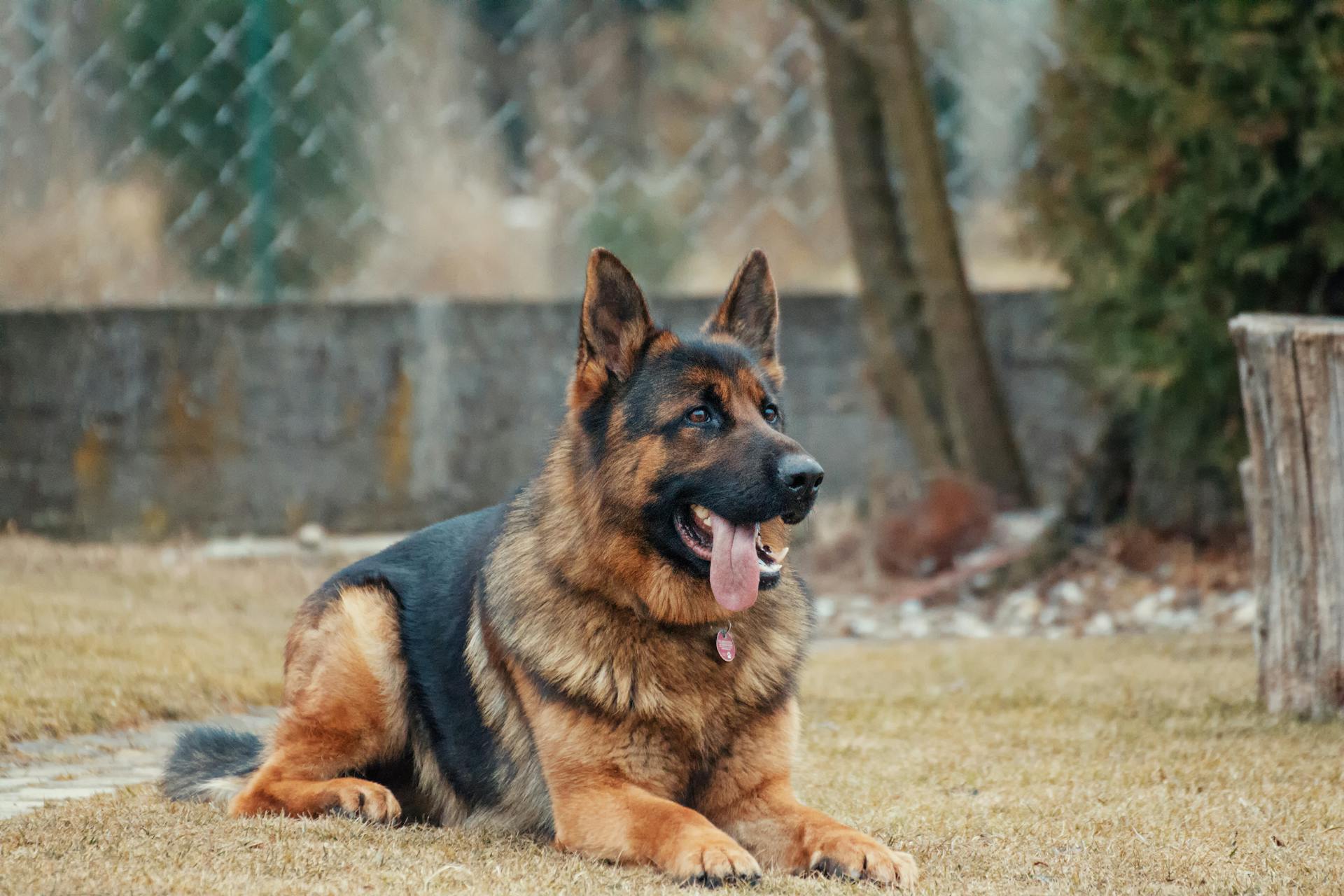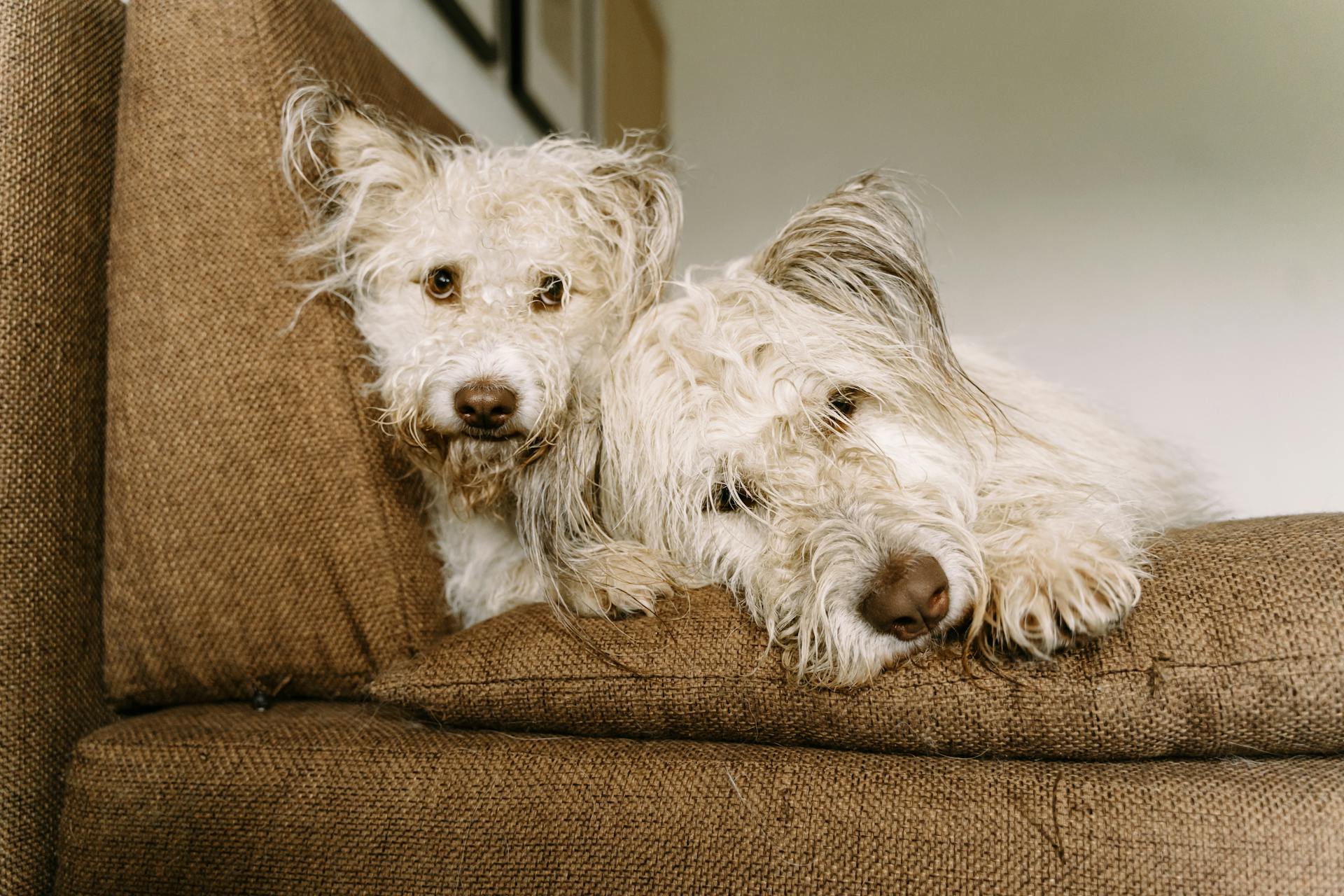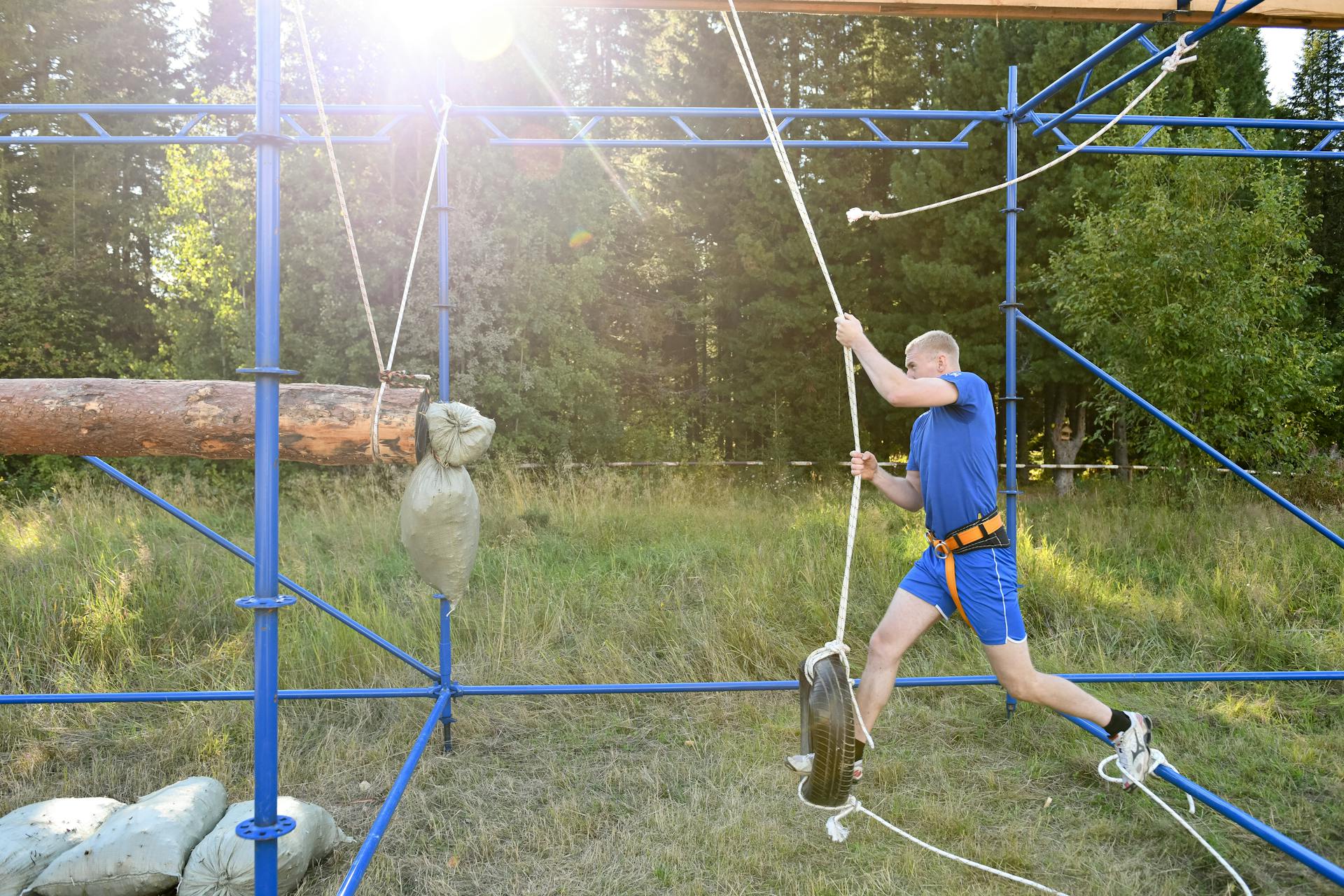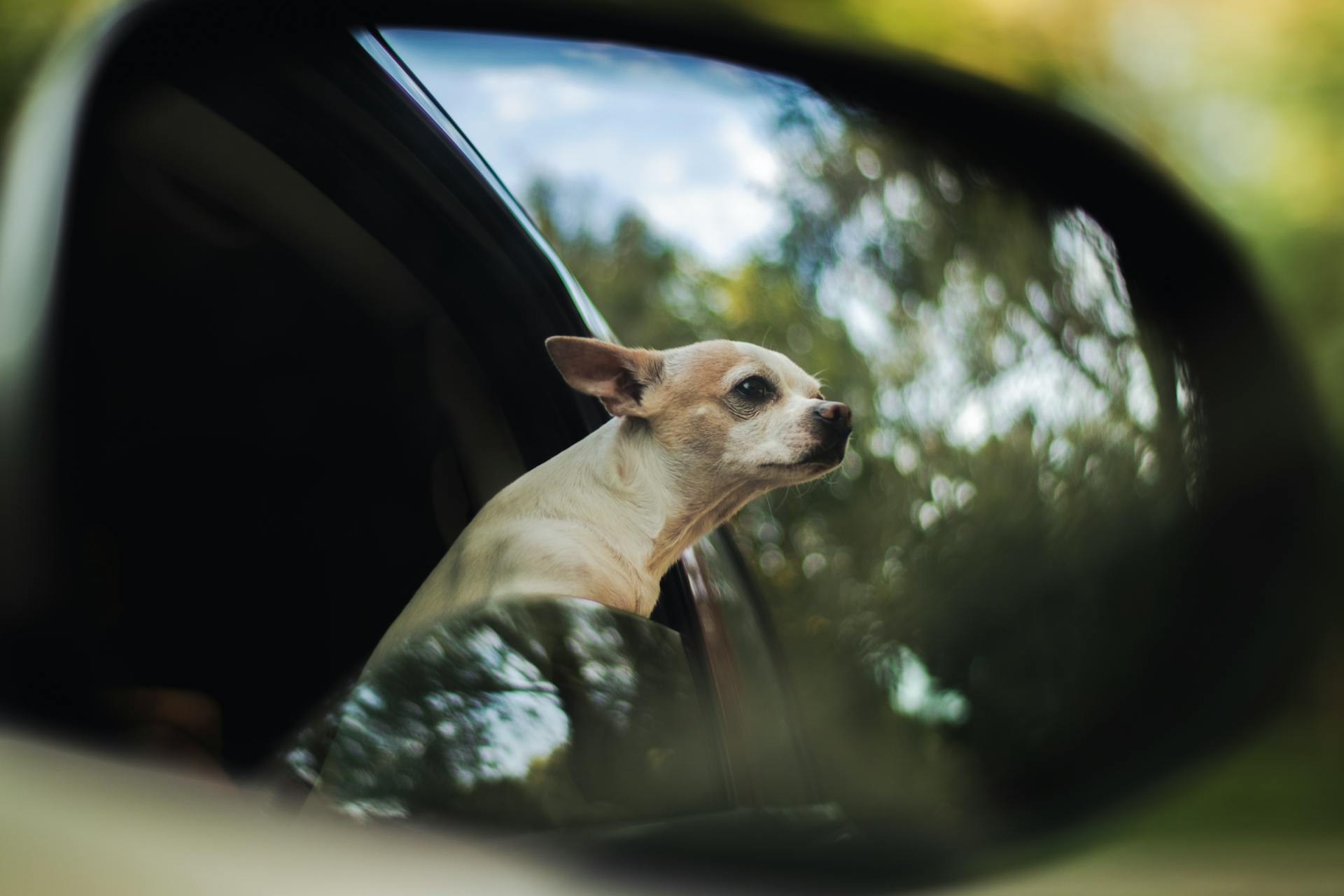
Separation anxiety in dogs is a common issue that affects many pet owners. According to research, up to 17% of dogs suffer from separation anxiety.
Separation anxiety can be caused by a combination of factors, including a change in environment, a move to a new home, or even a change in the owner's work schedule. This can lead to feelings of anxiety and stress in dogs.
Some common symptoms of separation anxiety in dogs include destructive behavior, barking, and howling. In severe cases, dogs may even attempt to escape or dig their way out of the house.
A healthy mind canine approach to separation anxiety training involves identifying and addressing the underlying causes of the anxiety.
What is Separation Anxiety?
Separation anxiety is a common issue in dogs, where they exhibit distress and anxiety when left alone or separated from their owners.
Dogs can develop separation anxiety due to a lack of proper training and socialization, which can lead to destructive behavior such as barking, chewing, and digging.
Separation anxiety is often triggered by a change in the owner's work schedule or a move to a new home, which can cause a dog to feel uncertain and anxious.
In severe cases, separation anxiety can lead to a dog's inability to relax or calm down when left alone, resulting in physical symptoms such as panting, pacing, and self-soothing behaviors.
The good news is that separation anxiety can be treated and managed with the right training and techniques, such as gradual separation, exercise, and mental stimulation.
Causes and Symptoms
Separation anxiety in dogs can be caused by a variety of factors, including never being left alone before, traumatic separation, and personality traits. A single traumatic event, such as a house robbery, can also lead to separation anxiety.
Life changes like a sudden switch in schedule, a move to a new house, or the sudden absence of a family member can also trigger separation anxiety. Research has even pointed to a lack of daily exercise as a possible cause.
Dogs with separation anxiety can exhibit a range of symptoms, including whining, panting, licking themselves or other objects, and destructive behavior. Some common signs of separation anxiety include:
- Whining
- Panting
- Licking themselves or other objects
- Biting or scratching at objects
- Urinating or defecating inside
- Barking nonstop
- Pacing
- Being unwilling to stop following their owners
- Appearing unsettled
These behaviors can be more noticeable while the pet parent is absent from the home, but can begin to manifest as the pet parent prepares to leave or first gets home.
Here's an interesting read: Home Protection Dog Training
What Causes?
Separation anxiety in dogs can be caused by a variety of factors, including never previously being left alone and traumatic separation.
Traumatic events, such as being abandoned in a shelter or experiencing a house robbery, can lead to separation anxiety in dogs.
Dogs that were brought into the home when they were younger than 8 weeks of age may develop separation anxiety due to their attachment formation being inappropriate when they leave their mother early.
Genetic factors can also play a role in the development of separation anxiety, with some breeds being naturally more secure and independent.
Recommended read: Dogs Gums Bleeding When Chewing Toy
Some herding dogs, like border collies, may experience separation anxiety if they don't get enough exercise or have a job to do each day.
A lack of daily exercise and a disruption in a dog's environment can also contribute to separation anxiety.
Dogs that have suffered a disruption in their environment, such as a pet parent leaving for an extended period of time or changing homes several times, may be more prone to separation anxiety.
What Are the Symptoms of
If your dog is suffering from separation anxiety, you'll likely notice a range of behaviors that can be distressing for both you and your pet.
Dogs with separation anxiety can become anxious while their owners are preparing to leave the house, and this anxiety can manifest in various ways.
Some common symptoms of separation anxiety in dogs include whining, panting, and excessive salivation.
Dogs may also exhibit destructive behaviors such as chewing on furniture, tearing up pillows, and scratching at walls.

In extreme cases, dogs with separation anxiety may even attempt to escape from their homes, causing damage to doors and windows.
Other signs of separation anxiety include urinating or defecating inside the house, barking nonstop, and pacing.
Dogs with separation anxiety may also be unwilling to stop following their owners, and may appear unsettled or restless.
Here are some common symptoms of separation anxiety in dogs:
- Whine
- Pant
- Lick themselves frequently
- Lick other objects (such as furniture)
- Bite or scratch at objects in their home
- Urinate or defecate inside
- Bark nonstop
- Pace
- Be unwilling to stop following their owners
- Appear unsettled
Testing and Diagnosis
Testing and diagnosis is a crucial step in identifying separation anxiety in dogs. It's essential to set up a camera with both video and audio recording capabilities to observe your dog's behavior and vocalization when you're not present.
To test for separation anxiety, you'll need to set up a camera in a room where your dog will be left alone, and have a friend or pet sitter help you out. This is because your dog may not exhibit stress with a family member present. The camera will allow you to observe your dog's behavior and vocalization without being present.
Discover more: Certified Behavior Consultant Canine
It's also important to note that some dogs may not display signs of stress immediately, so it's recommended to wait and observe for at least an hour after leaving your dog home alone. If your dog is stressed, they'll likely show signs of anxiety vocally, behaviorally, or both.
A free iOS app called Manything can convert your iPhone, iPod Touch, or iPad into a security camera, making it easy to surveil your dog's behavior. Video recordings are recommended, especially if neighbors complain, to avoid misdiagnosing your dog with separation anxiety.
Here are some common signs of separation anxiety to look out for:
- Visibly or audibly stressed behavior
- Shadowing a parent around the home
- Not having a video and audio camera set up in all areas where the dog will be
- Not actively monitoring the audio video for at least an hour after leaving the pet home alone
If your dog has separation anxiety, they may also have separation distress. However, if your dog is happy and unstressed with your departure as long as they're with another person, they may have isolation distress. It's essential to know the difference to determine the best course of treatment.
If this caught your attention, see: Separation Distress
Treating Separation Anxiety
Separation anxiety in dogs can be a challenging issue to address, but with the right approach, it is possible to help your dog feel more calm and secure when left alone.
Leaving special treats and toys can be a great way to distract your dog and provide them with something to look forward to during your time apart. This can be as simple as leaving a Kong toy filled with yogurt or canned dog food.
Puzzle toys are another great option for keeping your dog occupied while you're away. Just be sure to avoid bones and rawhides because dogs may eat them too quickly.
Dogs should never be punished for anxious behaviors, as this can actually make the problem worse by increasing their anxiety and stress.
Desensitization and counter-conditioning are important techniques for teaching your dog to be comfortable with time away from you. This can involve leaving them for short periods of time and gradually increasing the length of time, while also associating your departure with positive experiences.
For more insights, see: Hip Dysplasia in Great Pyrenees
You can also make your departure routine less distressing by desensitizing your dog to the signs you're about to leave, such as picking up your keys or putting on your coat.
It's possible to permanently cure a dog with separation anxiety, but it may take a lot of work and commitment. With patience and the right approach, you can help your dog feel more calm and secure when left alone.
Here are some tips to get you started:
- Leave special treats and toys to distract your dog and provide them with something to look forward to.
- Avoid punishing your dog for anxious behaviors.
- Use desensitization and counter-conditioning techniques to help your dog feel more comfortable with time away from you.
- Make your departure routine less distressing by desensitizing your dog to the signs you're about to leave.
By following these tips and being consistent, you can help your dog feel more calm and secure when left alone.
Prevention and Management
To prevent separation anxiety in dogs, it's essential to teach them that being alone is not scary. According to Dr. Bright, anxiety is to blame for your dog's behavior when he's alone, so punishing him for chewing or soiling the couch will only make him even more anxious.
Create a calm separation routine to help your dog feel secure. Dogs thrive on routine, and a consistent "leaving" ritual can teach them that though you're leaving, it will be the same as the last time you left; nothing terrible happened then, and nothing terrible will happen now.
Check this out: How to Teach a Dog to Search by Scent
To avoid leaving your pup alone too long, try to keep the time you're away to a minimum. Anxious dogs should not be left alone for more than 6-8 hours, and you should only increase the period of time you leave them alone gradually.
Here's a quick rundown of what you can do to help your dog feel more comfortable when you're away:
- Leave special treats and toys to distract them and provide positive reinforcement.
- Use puzzle toys or Kong toys filled with yogurt or canned dog food to keep them busy.
- Never punish your dog for anxious behaviors, as this will only make the behaviors worse.
By following these simple tips, you can help your dog feel more secure and reduce the likelihood of separation anxiety.
How to Manage
To manage separation anxiety in dogs, it's essential to teach them that being alone is not scary. This can be achieved by pairing potential stressors with non-stressful activities, such as grabbing your keys or backpack, with a calm and relaxed demeanor.
Dogs thrive on routine, so creating a calm separation routine is crucial. This can involve staying calm while preparing to leave, making sure not to give your dog tons of attention while leaving, and putting your dog in a safe, peaceful place with a toy or treat as you leave.

A safe cozy space can also help alleviate separation anxiety. This can be a crate or a corner of a room with a bed and food dishes, in an area that your dog has a positive association with.
Gradually increasing your puppy's alone time can also help prevent separation anxiety. Start by making these events short, then slowly increase the time your puppy spends alone, working up to several hours by the end.
It's also essential to avoid leaving your pup alone for more than 6-8 hours, and to only increase the period of time that you leave them alone gradually.
To distract your dog and provide positive reinforcement when you leave, leave special treats and toys, such as Kong toys or puzzle toys. These can be frozen and stuffed with yogurt or canned dog food, and can keep your pup busy for hours.
Here are some things to remember when managing separation anxiety:
- Leave special treats and toys to distract your dog and provide positive reinforcement
- Create a calm separation routine
- Provide a safe cozy space
- Gradually increase your puppy's alone time
- Avoid leaving your pup alone for more than 6-8 hours
- Don't punish your dog for anxious behaviors
- Don't crate your dog
- Don't use scary training equipment
Provide Regular Exercise
Providing regular exercise is a crucial part of preventing and managing separation anxiety in dogs. Regular exercise can help tire out a dog, making them less likely to feel anxious when left alone.
A good rule of thumb is to provide at least 30 minutes of exercise daily. This can be broken down into shorter sessions, such as a morning walk and an evening playtime.
Exercise is especially important for large, high-energy dogs with a lot of energy to burn off. A tired, contented dog is more likely to settle down when you leave.
You can also challenge your dog's mind with training sessions, puzzle toys, and cognitive games. These can be just as exhausting as physical exercise, and lots of fun too!
Discover more: Training a Dog to Lay down
Professional Help
If your dog's separation anxiety persists despite your best efforts, it's time to seek professional help. A canine behaviorist or veterinarian can be a valuable resource in addressing your dog's anxiety.
A canine behaviorist can spend time working with you and your dog, often during home visits, to analyze your dog's triggers, history, and home environment. They can identify triggers causing anxiety that you may not be aware of, and provide you with the tools to help with these behaviors.
A behavioral specialist will help you establish a successful relationship with your dog and ease their anxiety by providing you with the tools to mitigate these triggers.
Check this out: Dog Hearing Test at Home
When to See a Specialist or Vet
If you're struggling to help your dog with separation anxiety, it's time to seek professional help. A canine behaviorist or veterinarian can provide guidance and support to address the issue.
You may need to see a specialist if nothing else works to calm your dog's separation anxiety. A veterinarian can also help if you can't find an available canine behaviorist.
Your veterinarian will discuss your dog's home and environment to find out what may be triggering separation anxiety episodes. This is a crucial step in understanding the root cause of the problem.
For another approach, see: Skin Care for Dogs with Allergies
In some cases, certain diseases can cause behaviors that appear similar to separation anxiety, such as urinary tract infections that lead to incontinence. Your veterinarian can perform a urinary test to rule out medical issues.
Dogs in pain may also display restlessness, pacing, and panting, which can be mistaken for separation anxiety. Medication can help alleviate their discomfort and reduce anxiety-like behaviors.
Behavioral Specialist
A behavioral specialist can be a valuable resource for helping your dog overcome separation anxiety. They will work with you and your dog to identify the underlying causes of the anxiety.
They can help you analyze your dog's triggers, history, and home environment, which can be a game-changer in understanding what's going on. A behavioral specialist is essentially a canine psychologist who can get into your dog's headspace and find out what's causing the anxiety.
If you've tried making changes to your leaving routine, creating a safe space for your dog, and introducing other predictable habits, but still see no improvement, it may be time to seek expert help. A behavioral specialist can provide you with the tools and strategies to help your dog feel more secure and calm.
They will often conduct home visits to work with you and your dog, which can be really helpful in identifying triggers that you may not be aware of. By mitigating these triggers, you can establish a stronger, more trusting relationship with your dog and help ease their anxiety.
Take a look at this: Dog Nose Work Classes near Me
Myths and Misconceptions
Separation anxiety in dogs is not caused by the dog being left alone for long periods of time, it's actually a result of a deep-seated emotional response to being separated from their owners.
Some people believe that giving in to a dog's demands for attention will alleviate separation anxiety, but the truth is that this can actually make the problem worse.
Dogs with separation anxiety often exhibit destructive behavior when left alone, such as chewing or digging, but this is not a sign of boredom, it's a sign of stress.
Separation anxiety can affect any dog, regardless of breed or age, and it's not a reflection of the dog's intelligence or loyalty.
In fact, some dogs may even become more clingy and demanding as a result of separation anxiety, making it seem like they're being attention-seekers.
The key to overcoming separation anxiety is to establish a consistent routine and provide a safe and comfortable environment for your dog when you're away.
With patience, persistence, and positive reinforcement training, you can help your dog feel more secure and calm when left alone.
Frequently Asked Questions
Do puppies grow out of separation anxiety?
No, puppies do not grow out of separation anxiety on their own. Seeking professional help from an experienced trainer is the most effective way to address this issue.
Sources
- https://www.funpawcare.com/dog-behavior/dog-separation-anxiety/
- https://www.akc.org/expert-advice/training/dog-separation-anxiety/
- https://www.24petwatch.com/blog/8-ways-to-help-with-dog-separation-anxiety
- https://manypets.com/us/blog/separation-anxiety/
- https://www.mspca.org/pet_resources/separation-anxiety-and-your-dog/
Featured Images: pexels.com


